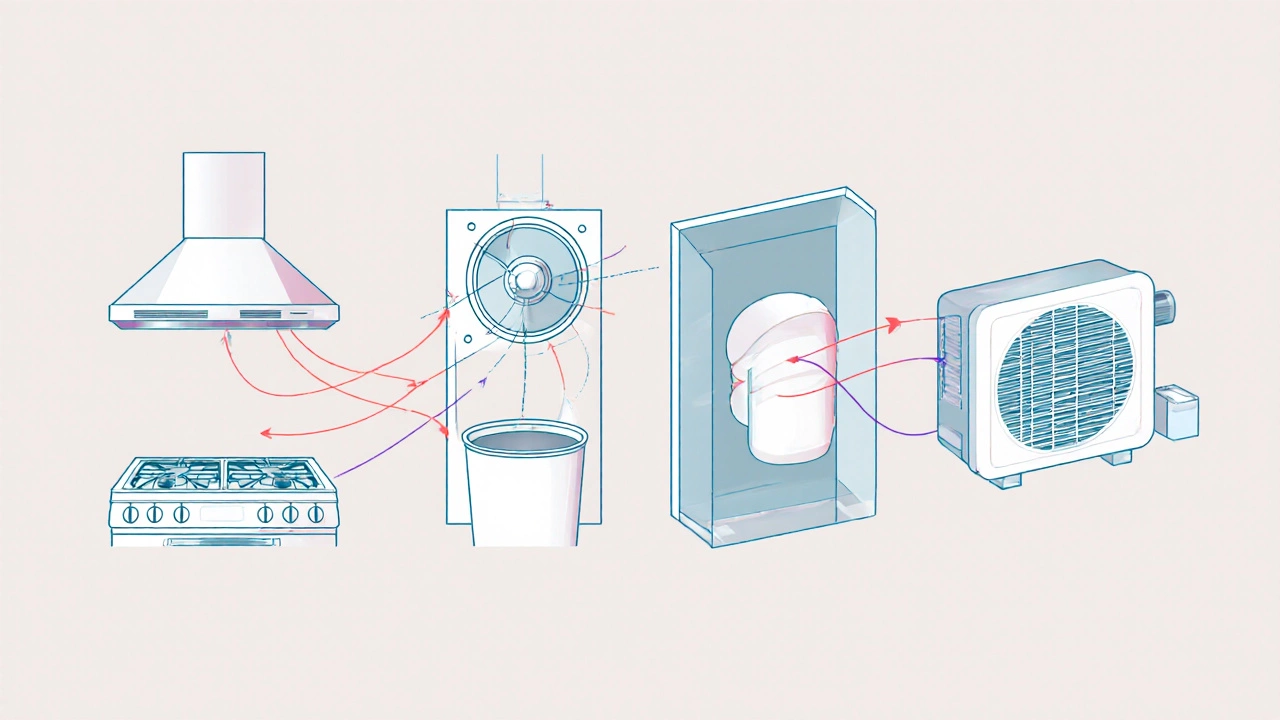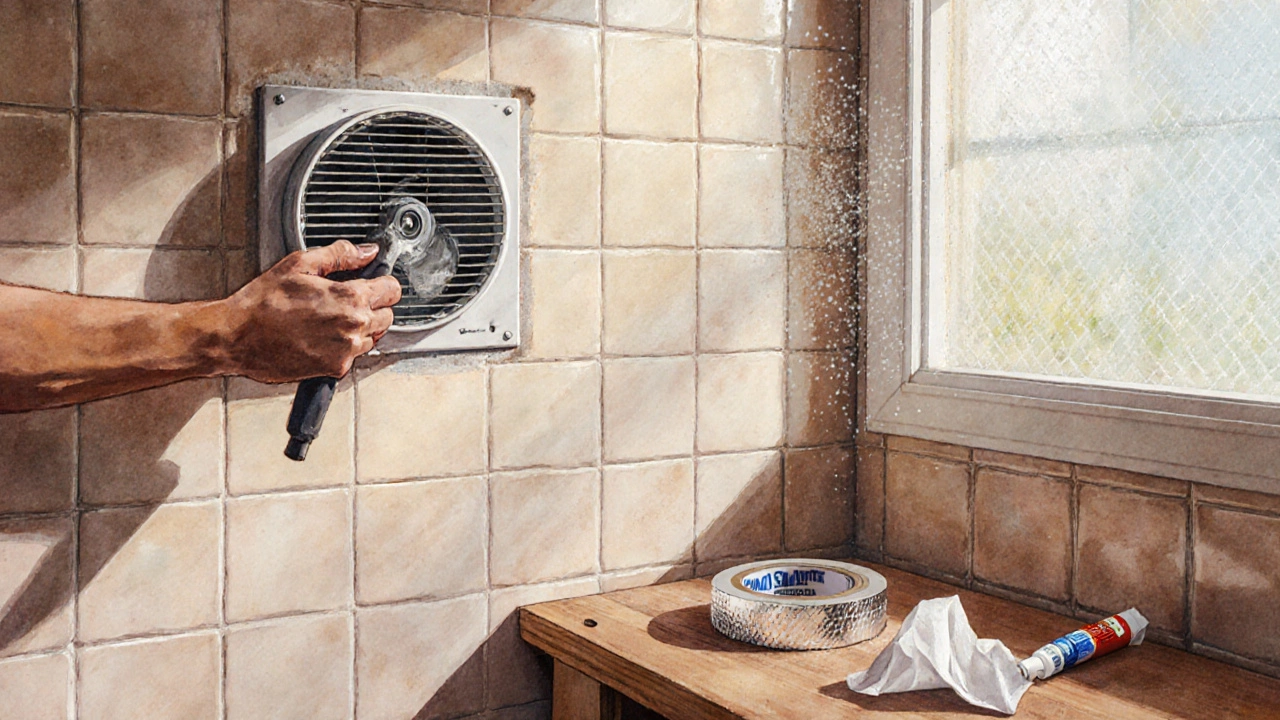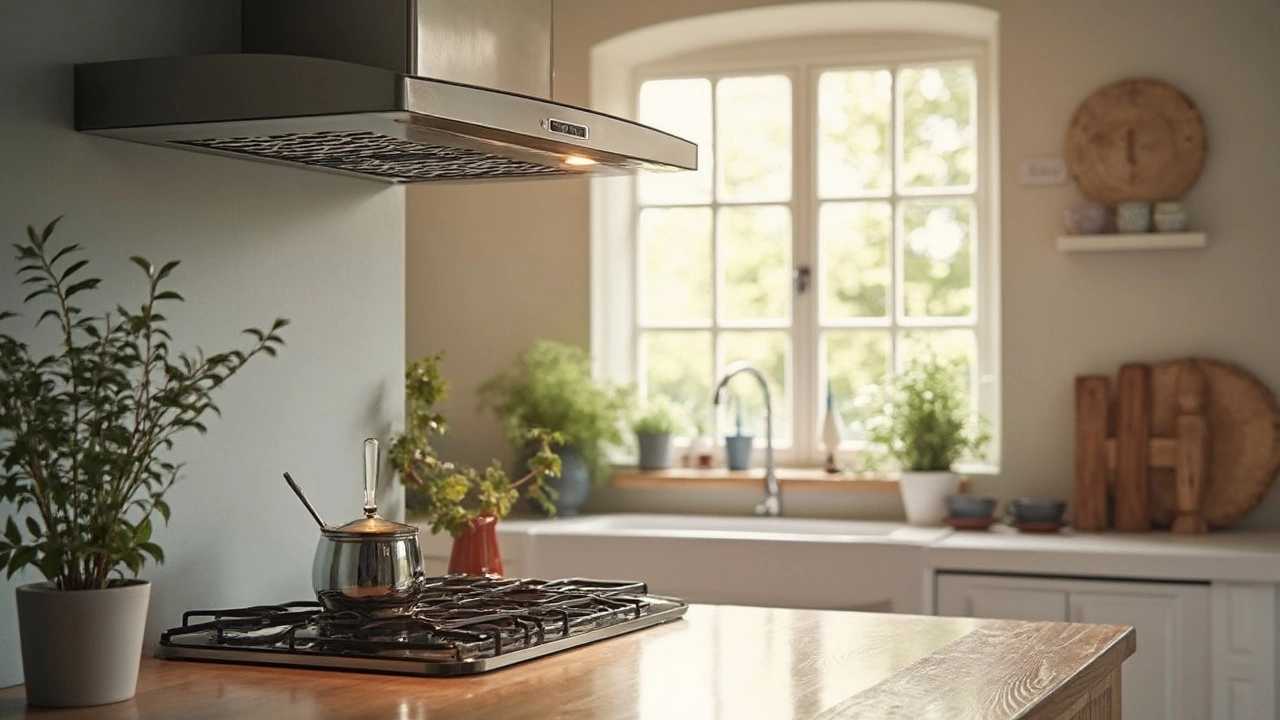
- 26 Oct 2025
- Gideon Thornton
- 0
Extractor Fan CFM Calculator
Determine Your Extractor Fan Needs
Calculate the minimum CFM rating required for your kitchen or bathroom based on room dimensions. This helps you choose an appropriately sized extractor fan that meets UK ventilation requirements.
Room Dimensions
What This Means
Enter your room dimensions to see the minimum CFM rating required.
Room Volume (ft³) ÷ 100 = Minimum CFM
Recommended CFM Ratings
Kitchen Fan
Minimum 15 L/s (30 CFM) for small kitchens
Recommended 300-400 CFM for standard kitchens
Best practice 500+ CFM for large cooking areas
Bathroom Fan
Minimum 30 L/s (60 CFM) for small bathrooms
Recommended 70-100 CFM
Best practice 100+ CFM for larger bathrooms
Quick takeaways
- Extractor fans control moisture, odors and harmful pollutants in kitchens and bathrooms.
- Signs you need one include persistent condensation, mould smell, or high humidity.
- Choose a fan based on airflow (CFM), noise level and compliance with UK Building Regulations.
- Regular cleaning prevents most faults; professional repair is cheap compared to water‑damage costs.
- Natural ventilation works for mild climates, but an extractor fan gives reliable control year‑round.
When a friend asks, "Do I really need an extractor fan?" the answer depends on health, comfort and the law. Below you’ll discover what an extractor fan actually does, why it matters for indoor air quality, and how to decide if your home truly needs one.
Extractor fan is a mechanical ventilation device that pulls humid or odorous air out of a room and exhausts it to the outside. In the UK it’s most common above cooking ranges and in bathrooms, but the principle applies to any space that generates moisture or fumes.
What an extractor fan actually does
At its core, an extractor fan removes three main contaminants:
- Water vapour that condenses on surfaces, leading to damp and mould.
- Odour‑bearing molecules from cooking, cleaning or personal hygiene.
- Fine particles and gases that reduce indoor air quality is the measure of pollutants, humidity and ventilation in an indoor environment.
By exhausting these to the outside, the fan helps keep walls, ceilings and fixtures dry, protects health, and reduces the load on heating systems.
Why you might need one - health and building reasons
Moisture is the enemy of a healthy home. When warm, moist air meets cool surfaces it condenses, creating the perfect breeding ground for mold is fungi that grow on damp material and can trigger allergies, asthma and respiratory infections. In the UK, the Health and Safety Executive (HSE) links poor ventilation to increased asthma rates, especially in children.
Beyond health, the UK Building Regulations are statutory requirements that set minimum standards for construction, including ventilation (Part F). If you’re installing a new kitchen or bathroom, the regulations require a mechanical extraction rate of at least 15 litres per second for kitchens and 30 litres per second for bathrooms.
Even if you’re not rebuilding, many local councils enforce these standards for major refurbishments, so a compliant fan can save you headaches later.
Tell‑tale signs you need an extractor fan
Look for these clues around the house:
- Persistent steam on mirrors after a shower.
- Visible water droplets on kitchen cabinets or plaster.
- Musty or sour smell that worsens after cooking or bathing.
- Peeling paint, wallpaper bubbling, or a slight bubbling noise under walls - signs of hidden damp.
- Higher than normal indoor humidity (above 60 %). You can check with a cheap hygrometer.
If two or more of these appear, the odds are high that you’re dealing with excess moisture and need a dedicated extraction solution.

Choosing the right fan for your space
Not all fans are created equal. Here’s a quick guide:
- Kitchen range hoods - positioned over the stove, they come in ducted (exhaust to outside) and recirculating (filter‑only) styles. Ducted is far more effective at removing grease and moisture.
- Bathroom fans - usually wall‑mounted, rated by cubic feet per minute (CFM). The rule of thumb: bathroom volume (ft³) ÷ 100 = minimum CFM.
- Inline fans - installed within ducts, ideal for long runs or when space is limited.
- Heat Recovery Ventilators (HRV) - HRV is a system that exchanges stale indoor air with fresh outdoor air while conserving heat. They’re overkill for a single bathroom but great for whole‑house ventilation in airtight builds.
Key specs to compare:
| Spec | What it means |
|---|---|
| CFM (cubic feet per minute) | Airflow; higher numbers move more moisture. |
| dB(A) noise level | How loud the fan is at full speed; look for 30‑40 dB for quiet rooms. |
| Energy rating | Fans with EC motors use up to 70 % less electricity. |
For most UK homes, a kitchen hood with 300-400 CFM and a bathroom fan of 70-100 CFM hits the sweet spot.
Installation basics - what you can DIY and when to call a pro
Installing a fan isn’t rocket science, but you must respect electrical safety and ventilation paths.
- Plan the duct route. The shortest, straight‑line path to an external wall or roof vent minimises resistance.
- Cut the opening. Use a hole‑saw matching the fan’s diameter; keep the cut square to avoid gaps.
- Seal the joint. Apply UL‑rated foil‑backed tape around the duct collar and secure with silicone sealant.
- Wire the switch. Connect the fan to a dedicated switched‑off circuit with a Pull‑Cord or wall switch. In the UK, a qualified electrician must handle any new wiring.
- Test for airflow. Hold a piece of tissue near the vent - it should be pulled away briskly.
If you’re uncomfortable with any step, especially the electrical work, hiring a certified installer will keep you compliant with Part F.
Maintenance - keep it humming, avoid costly repairs
Most extractor fan failures stem from grime build‑up or motor wear. A simple maintenance routine can extend life by years:
- Wipe the exterior grille monthly with a damp cloth.
- Every 3‑6 months, remove the cover (usually clipped) and clean the fan blade with a soft brush.
- Inspect the duct for dust pockets; a vacuum attachment works well.
- Check the motor for unusual noises - rattling may signal bearing wear, which a professional can replace for ~£80‑£120.
Common faults you might encounter:
- Motor burnout. Usually from running the fan continuously without an automatic humidistat.
- Electrical short. Corrosion on the switch contacts, often caused by high humidity.
- Blocked duct. Leaves, chimney soot or insulation can restrict flow, reducing CFM dramatically.
When any of these symptoms appear, call a local repair service. In Bristol, most firms can visit within 24 hours and charge a flat £60‑£80 call‑out fee plus parts.

Alternatives and how they compare
Sometimes homeowners wonder if opening a window is enough. Below is a quick side‑by‑side look.
| Feature | Extractor fan | Window opening | HRV |
|---|---|---|---|
| Moisture control | High - active removal | Low - depends on wind | Very high - continuous exchange |
| Odour removal | High | Moderate | High (filters) |
| Energy loss | Medium (exhausted warm air) | Low (no fan) | Low - heat recovered |
| Installation cost | £150‑£400 | £0 | £800‑£1500 |
| Regulation compliance | Meets Part F | Often non‑compliant | Meets Part F |
For the average UK household, the extractor fan wins on cost‑effectiveness and regulatory compliance. HRVs shine in ultra‑tight builds or new builds aiming for Passivhaus standards.
Cost considerations and return on investment
Buying a decent kitchen hood (300 CFM, EC motor) runs £180‑£350. Bathroom fans sit around £50‑£120. Installation adds £80‑£150 if you hire an electrician.
What’s the payoff? Studies from ASHRAE is the American Society of Heating, Refrigerating and Air‑Conditioning Engineers, which publishes standards on indoor air quality show that each 10 % reduction in humidity cuts mould‑related repair costs by up to 35 %.
In plain terms, a properly vented kitchen or bathroom can prevent a £2,000‑£5,000 water‑damage repair bill, making the fan a cheap insurance policy.
Bottom line - Do you really need one?
If you cook, shower, or run a dishwasher daily, the answer is a resounding yes. A well‑chosen and maintained extractor fan protects your health, your home’s structure and keeps you on the right side of UK ventilation law.
For occasional cooks in a small flat with ample windows, a high‑performance kitchen window may suffice, but you’ll still benefit from a modest fan during rainy days when you can’t open a window.
Assess the signs, check the humidity, and match the fan’s specs to your room size. In most cases, the investment pays for itself within a few years through avoided repairs and a healthier indoor environment.
Frequently Asked Questions
What CFM rating do I need for a kitchen extractor?
Calculate the volume of your kitchen (length × width × height) and divide by 100. The result is the minimum CFM. For a 12 ft × 10 ft × 8 ft kitchen, you need at least 96 CFM, but most homeowners choose 300‑400 CFM for grease and steam control.
Can I install a fan myself without an electrician?
If the fan plugs into an existing switched socket, you can DIY. However, adding a new dedicated circuit or hard‑wired switch requires a qualified electrician under UK wiring regulations.
How often should I clean my extractor fan?
External grilles should be wiped monthly. The internal blades and motor housing need a deep clean every 3‑6 months, especially after heavy cooking periods.
Is a recirculating (filter‑only) fan good enough?
Recirculating units remove grease but do little for moisture. In humid UK climates they often fail to meet Part F requirements, so a ducted fan is the safer choice.
What are the signs of a failing bathroom fan?
A weak or whirring sound, reduced airflow (you’ll notice steam staying in the room), or a persistent musty smell. Those indicate motor wear or duct blockage.



